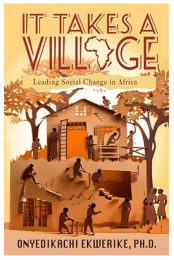In this book review, Chibuzor Azubuike takes a deep dive into It Takes a Village: Leading Social Change in Africa (2023) by Nigerian scholar Onyedikachi Ekwerike, Ph.D., who is currently a lecturer at the Institute for Leadership Advancement in the Terry College of Business at the University of Georgia.
This begins with a foreword from Nyasha GuramatunhuCooper, Ph.D. She writes with the endearment of a mother who is proud of her son’s achievement, and yet firmly charges readers, using parables, to not only read this book but implement Ekwerike’s submission. As a Zimbabwean leadership scholar, she is excited to read a leadership book by a fellow African, given that African scholars are under-represented in leadership curriculum and literature. She, however stated that she could be scared if anyone reads this book and does not take positive actions towards social change.
 In the book’s introduction, Ekwerike recounts his own story. Through leading a mental health organization in Nigeria, as well as being part of leadership development programs like the Mandela Washington Fellowship, he realized that there was a need for more in order to do more, which led him to a doctoral program and ultimately to writing this book. He went through the learning process and then wrote this book to teach young people how to learn social change effectively. This book is a product of qualitative research work for his Ph.D. dissertation.
In the book’s introduction, Ekwerike recounts his own story. Through leading a mental health organization in Nigeria, as well as being part of leadership development programs like the Mandela Washington Fellowship, he realized that there was a need for more in order to do more, which led him to a doctoral program and ultimately to writing this book. He went through the learning process and then wrote this book to teach young people how to learn social change effectively. This book is a product of qualitative research work for his Ph.D. dissertation.
In chapter one, The Problem with Nigeria, Africa, you will notice that Nigeria is crossed out, coupled with the use of illustrations. Both styles are used in Okechukwu Ofili’s books, a Nigerian author who writes with sarcasm. In Ekwerike’s book, Nigeria represents Africa, as he says he is providing a holistic approach, while the context and research for this book is centered in Nigeria, the problems and processes to address those problems apply across the continent.
He says in the introduction he is writing for “my people” and also to a global audience. This personalization can be seen through use of Pidgin English: “Upon say we dey inside river, yet we no see fish chop” (p.4) This idiom refers to the abundant natural resources in Nigeria, yet the people cannot access them. Further stated that as of 2017, Nigeria has 1,287 non-profits in Nigeria and more is needed for the volume of work that needs to be done; therefore Nigeria and Africa at large has a problem of leadership.
In Chapter two, Ekwerike posits that African-centered leadership is key to creating change. He cites Ubuntu, the African philosophy that focuses on interconnectedness, the importance of relationships, and interdependence between people. Therefore, an African approach to leadership is a bottom-up approach. It is collective and participatory.
Moving on to chapter three, Ekwerike combines theory and experience to share insights on Social Change as Collective Leadership Work. Social change involves serving the needs of marginalized people, disrupting discriminatory systems and creation of a just society. He emphasized how many social problems are rooted in systemic inequality and injustices, such as access to access to education, using the current work being done by young Africans in Kenya and South Africa to illuminate this example.
As Ekwerike progresses into chapter four, A Method to the Madness, he draws strength from the work of Sonia Ospina and colleagues, recommending four crucial activities that should guide the work of leading change: raising awareness, organizing, providing direct services and finally, advocating for policy change. The way Ekwerike unpacks each of the four crucial activities while using the work change leaders in Africa, Mafule from South Africa and Viola from Kenya, makes this chapter the crux of the book. If this book were a machine, chapter four would be the engine.
Chapter five, Identifying Stakeholders: Who Should be at the Table? dwells on engaging stakeholders and the need for collaboration, they include business and non-profit organizations, government officials, celebrities, and volunteers. This feels pretty important for the “collective” part of the work.
 Chapter six is another significant chapter in this book, which he titled A Compass For Engagement: Leadership Principles and Practices That Facilitate Social Change. It serves as a control box that manages the technicalities within the system. Here he introduces his readers to an integrative framework and process called Engaged Leadership as Design, that outlines principles and practices to facilitate social change. Drawing from adaptive leadership, collective leadership, and design thinking, the six phases include empathy, diagnose the situation, ideate, intervention, test, and implement. He inserts a workbook within the book to help his readers take action. By doing so, he alleviates the fears of Nyasha GurumatunhuCooper, in her foreword, where she affirmed that nothing changes if the readers does nothing as stated above. The value of this workbook is that it provides a starting point for anyone who desires to create change in their organization or community.
Chapter six is another significant chapter in this book, which he titled A Compass For Engagement: Leadership Principles and Practices That Facilitate Social Change. It serves as a control box that manages the technicalities within the system. Here he introduces his readers to an integrative framework and process called Engaged Leadership as Design, that outlines principles and practices to facilitate social change. Drawing from adaptive leadership, collective leadership, and design thinking, the six phases include empathy, diagnose the situation, ideate, intervention, test, and implement. He inserts a workbook within the book to help his readers take action. By doing so, he alleviates the fears of Nyasha GurumatunhuCooper, in her foreword, where she affirmed that nothing changes if the readers does nothing as stated above. The value of this workbook is that it provides a starting point for anyone who desires to create change in their organization or community.
Chapter seven, which is the last chapter, throws light on Understanding Cultural Barriers to Engagement and the need for changemakers to consider context and conceptions, as these can impede or even halt progress, for example cultural barriers in the quest to reduce gender inequality in Kenya.
This book, on the one hand is an academic text, and it also reads like a conversation or a letter written in Nigerian daily lingo. Ekwerike switches from the class to the street language quickly. In using the work of young Africans as a case study in this work, he makes a statement that young people can lead, which anchors on the agency of young people and debunks the fallacious notion of leadership for mature adults as just ageism manifesting. The illustrations with the funny captions have profound underpinnings; however, some of them did not have a caption to help the readers interpret the meaning faster, this could have been intentional, given that Ekwerike says, “You get it? If you don’t get it, forget about it.” (p. 8) Perhaps it is a puzzle the readers have to deal with. Again, his work focuses on young people, this is timely given the not too young to lead campaign and the high population of youths in Nigeria.
In summary, Ekwerike himself is a changemaker whose passion shines through in this book. He is a leadership scholar to look out for, his hands-on experience working with Post Partum Support Network, an NGO in Nigeria, coupled with his academic training, makes him an authority in this field, the merits that comes from leveraging on the former and the latter is evident in the wealth of knowledge in It Takes a Village: Leading Social Change in Africa.
References
Ekwerike, O. (2023). It Takes a Village: Leading Social Change in Africa. Masobe Books.
 About the author
About the author
Chibuzor Mirian Azubuike is a Ph.D. candidate in leadership communication at Kansas State University. She is also a graduate teaching assistant at the Staley School of Leadership, where she teaches LEAD 350: Culture and Context of Leadership. She has experience in community development, facilitating leadership trainings and forced migration studies. Her interests include humanitarian interventions, civic leadership, youth development women and migration, and civic engagement.
